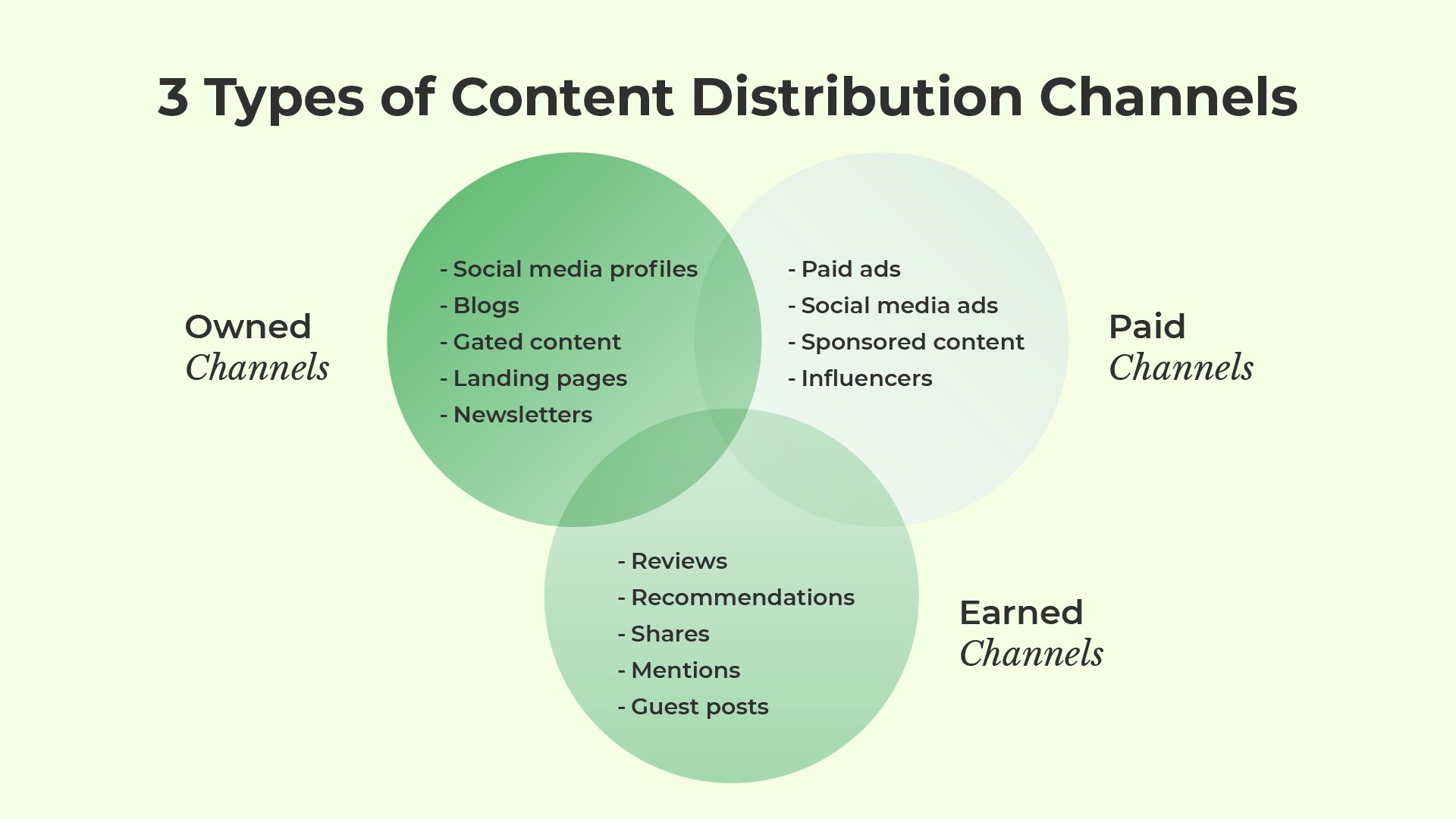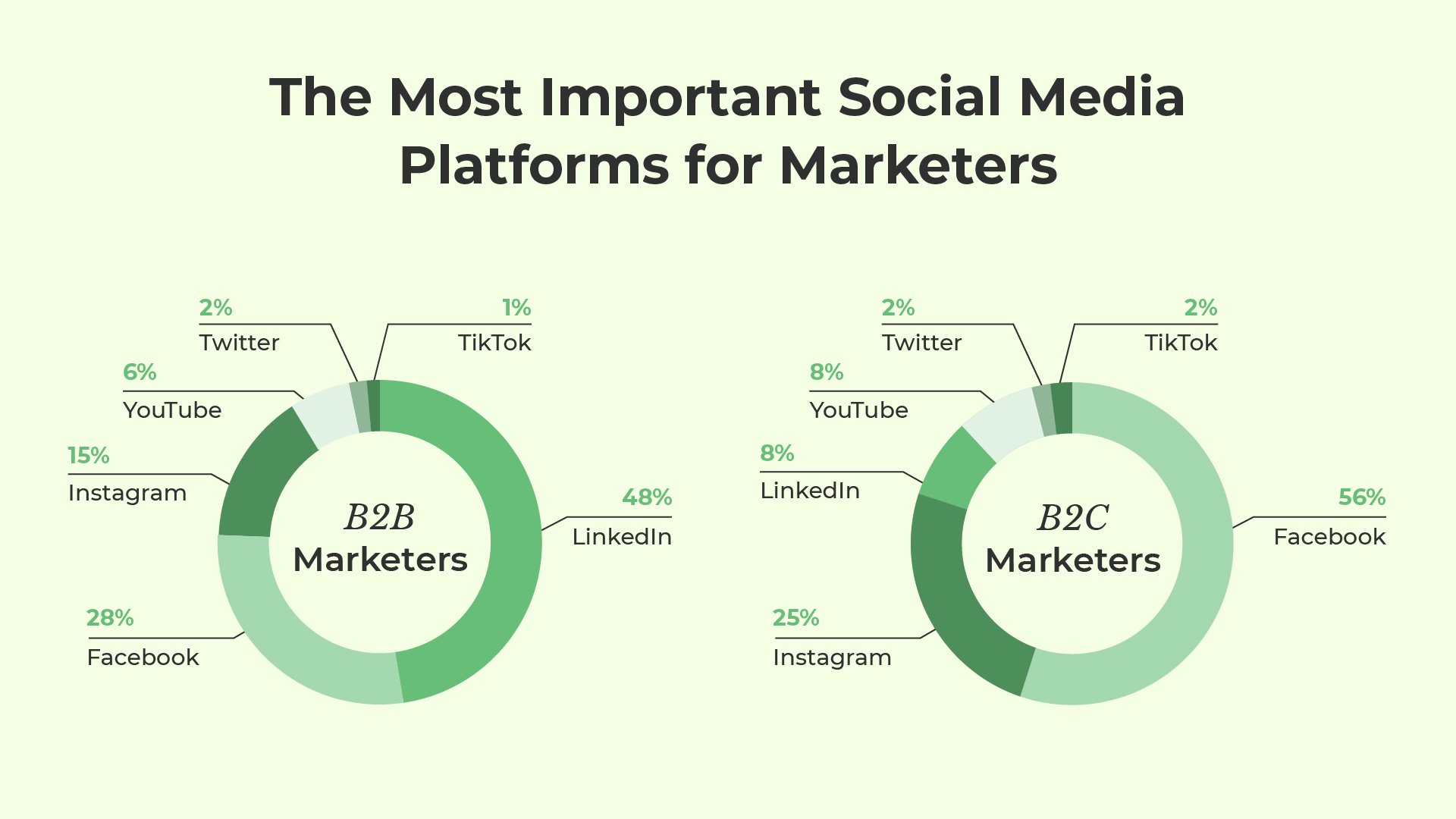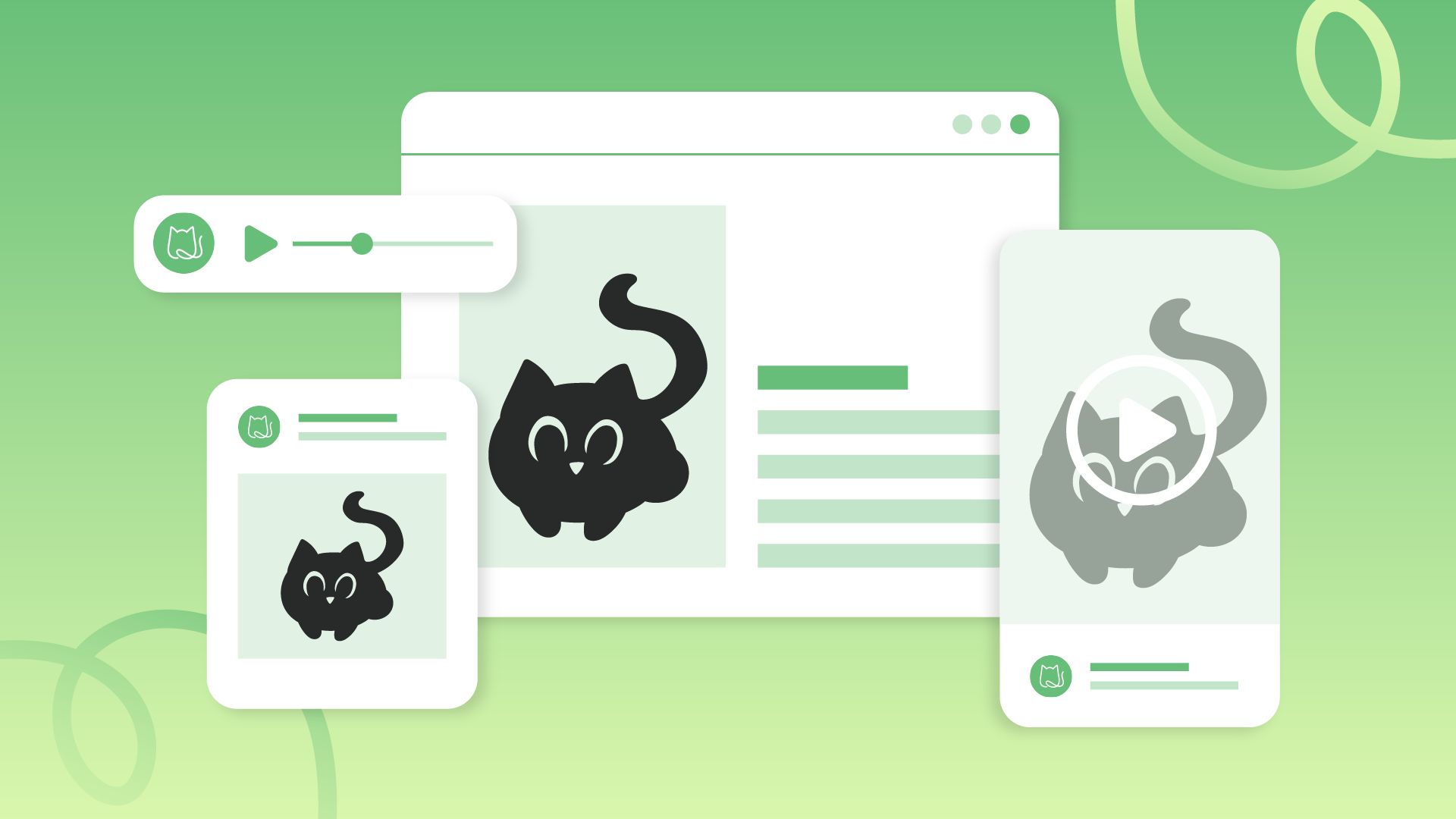How to Refine Your Content Distribution Strategy
High-quality content creation is crucial for digital marketing, but you can’t just write in a vacuum. How and where it’s distributed is equally important to the content itself. If your distribution strategy isn’t up to scratch, your target audience may never see even your best piece of content. Read on to find out how to refine your strategy to reach a wider audience and ensure that your content marketing efforts are well spent.

Manage all your social media accounts in one place.
Craft, schedule, & auto-post content to all your social channels, then track analytics and manage interactions from a single, easy-to-use dashboard.
What is a content distribution strategy?
A content distribution strategy is a plan that shows how you will share and promote content to your target audience.
The types of content you might share include:
- Articles and blog posts
- Whitepapers and guides
- Research studies
- Case studies
- Infographics
- Checklists
- Ebooks
- Templates
- Product landing pages
- Videos
- Podcast episodes
- Newsletters
There are three main types of content distribution channels: owned channels, earned (or shared) channels, and paid channels.
Owned channels
These are platforms owned by your brand. For instance:
- Blogs
- Gated content
- Landing pages
- Social media profiles
- Email newsletters
- Mobile apps
Earned or shared channels
Earned or shared content distribution channels are third-party platforms where others share or promote your content to reach a larger audience. There’s no direct payment involved in earned or shared content distribution. Methods of distribution include:
- Shares
- Mentions
- Reviews
- Guest posts
Paid channels
Paid content distribution channels are those where you pay to promote and share your content with your target audience. Paid channels include:
- Paid ads
- Social media ads
- Sponsored content
- Influencers and creators

To build an effective content distribution strategy, you should choose your preferred channels based on your content type and the preferences of your target audience.
Why is content distribution important?
Content distribution is the bridge between your content and your audience. It’s how they get to see your content and engage with it. So it’s important in many ways, including:
- Increased brand awareness: Your brand message is reinforced every time someone sees it.
- Drive website traffic: An effective distribution strategy will attract paid and organic traffic to your website.
- Competitive edge: Even in an oversaturated market, a successful content distribution strategy can set you apart from your competitors.
- Efficient use of resources: Making sure your content is directed where it’ll have the most impact saves you time and money.
- Better return on investment: Using content distribution tactics to reach the right audience leads to higher engagement levels and more return on your investment.
- More customer engagement: Reaching customers likely to have the most interest in your product or service will mean they’re more likely to engage with your content.
- Quality lead generation: When the right people see quality content, they’re more likely to become promising leads.
- Higher conversion rates: The hotter your leads, the higher your conversion rates.
- Better growth and reach: The wider and more effectively you cast your content net, the more you expand your audience.
- Increased revenue: Greater reach, more engagement, more leads, and higher click-through rates will inevitably lead to increased revenue.
Content distribution isn’t just about sharing content; it’s about using your content in a way most likely to have the maximum possible impact.
When should you refine your content distribution strategy?
If you notice that your website traffic is declining, your engagement rates are low, and you’re missing your marketing goals, it could be a sign your content distribution strategy isn’t as effective as it could be. There may be various reasons for this – for instance, there could have been algorithm changes on the platforms you’re using, or perhaps your product or service has changed and is no longer as aligned with your current strategy.
Now’s the time to use insights from your data and analytics to pinpoint where the problem lies and develop a more effective approach.
How to refine your content distribution strategy in 7 steps
1. Understand your audience
A recent survey found that 47% of content marketers recognize that understanding their audience is pivotal to success in content marketing. This came ahead of other important factors, such as SEO and publishing more content.
Creating customer personas is a highly effective method of gaining a deeper understanding of your audience. You can ensure your content is relevant to your ideal customer by researching and fleshing out the details of their demographics, interests, and challenges. Not all customers are the same, and segmenting your audience into different groups means you can personalize your content and make it more relevant to each audience segment.
Find out where your audience spends their time – are they on social media, reading blogs, or do they prefer to engage with email? Building a roadmap of your customer’s journey from when they become aware of your brand to when they make a purchase gives you further important insights. By mapping their journey, you can understand their interactions with your content and identify opportunities to engage with them more effectively.
Finally, one of the best ways to gain audience insights is to ask them directly. Conduct online surveys and collect feedback to learn more about their preferences, pain points, and expectations.
2. Audit your existing content performance
Revisit and evaluate your existing content assets to identify which work well and which need improvement.
These are some relevant questions during your audit:
- Which of your previous content pieces gained the most engagement, shares, and feedback?
- Which are your most effective channels?
- Which content and platforms didn’t have the impact you’d have liked or expected?
Make a plan to update and improve content where necessary, to move it to different platforms when appropriate, and to repurpose strong content for different platforms.
3. Decide your budget
Use the insights about your audience and the audit of your existing content to decide how to get the best return on any investment of your money and your time. Decide how much of your audience you can attract through organic means and how much you’ll invest in paid channels. Which channels are likely to make the most impact and give you the best returns?
Don’t be tempted to chase every opportunity, but prioritize spending on channels where your audience is likely to hang out. And use hard data to make these decisions, as this will give you better results than guesswork. Review and adjust your budget as you continue to analyze your marketing data.
4. Design your strategy
A one-size-fits-all approach isn’t sufficient when designing your content distribution plan. Your decisions will depend on the insights you gain from your data and research and factors such as your type of business and audience.
Preferred social media channels, for instance, will depend on whether you’re targeting a B2C or B2B audience. 56% of B2C marketers state that Facebook is their most important social media marketing platform, while for B2B marketers, the most important platform is LinkedIn.
The key components of your strategy should be designed to meet the unique needs of your business, using all the information you’ve gained from analyzing your audience, content, and budget.
The best business decisions are driven by accurate data, so as part of your strategy, decide which key performance indicators you’re going to track. These could include:
- Impressions
- Follower growth
- Social share of voice
- Conversion rate
- Bounce rate
- Cost per click (CPC)
- Customer satisfaction scores (CSAT)

5. Put your strategy into action
Make use of content distribution tools
Once you’ve designed your strategy, content distribution tools can help you put it all into action. These tools optimize and automate sharing and promoting content across various channels to increase content discovery. Content distribution software can save you time, increase the visibility of your content, allow you to target customer segments, and ensure a consistent brand message.
Loomly is a social media content distribution tool that allows you to create, manage, schedule, and publish content across multiple social media channels. Among its many advantages, it simplifies your workflow, helps you track social media engagement, and provides tools to analyze the performance of your social media content.
Plan your calendar
Plan your publishing calendar so that you’re well-organized and able to deliver quality content at the right time. Tools such as Loomly can help you visualize your calendar, prepare your content in advance, and set it to publish automatically at specific posting times on your social media accounts.
Create high-quality content
We started by pointing out that high-quality content is wasted if you don’t have an effective content distribution strategy. But equally, having a first-class strategy without engaging content is no good. The two must work together to reach the right audience and draw them in with your content.
Consistent brand messaging
Your brand message should always be consistent in whichever channel it’s presented. Content distribution tools can help here, as they centralize control and make brand consistency easier to track.
Search engine optimization
SEO can have a huge impact on your reach. Make all your content accessible by optimizing it for search engines. Choose relevant keywords and analyze the intent of those who use them to search the web. Find out what they’re looking for, and make sure your content aligns with their intentions. Don’t forget that social media posts and profiles can all be optimized, and use hashtags to reach more potential customers.
Create shareable content
Increase the reach of your content by encouraging people to share. Include social sharing buttons and embed codes where you can. And don’t forget to add a call to action directly asking your audience to like, share, or comment on your posts.
Harness the power of influencer marketing
Social media influencers have a large, attentive audience, and you can increase your reach by hiring them to spread the word about your brand.
Contrary to what you might believe, it doesn’t need to be expensive to work with influencers. In fact, 83% of influencers say they would be happy to work with a brand if the value of the product is high enough, or sometimes, just if they really love the brand.
Repurpose content
Make the most of your content by reusing it on different content distribution platforms to reach a broader audience. This is a popular strategy, with 42% of content marketers saying that repurposing and updating existing content was a factor that led to success in their marketing campaigns.
A simple approach is just to modify the content for each specific platform. But if you have the time and resources, you could even go as far as creating unique content for each platform.
For example, Starbucks promoted the 20th birthday of its Pumpkin Spice Latte (PSL) on Instagram, Facebook, and X (Twitter), using very different content for each social media platform. They posted a reel on Instagram – keeping their strongest content for their main social media platform:
A new, temporary profile picture on Facebook promoted the same message:
And they used a special promotional offer on X (Twitter) to convey their message:
Twenty years ago, our PSL brought fall to all.
Celebrate with us tomorrow, 10/10, and get a free sheet of our temporary tattoos full of pumpkin love with any purchase of a Pumpkin Spice Latte (hot, iced, blended). At participating stores in U.S. and Canada, while supplies… pic.twitter.com/wb3hp1UMBz
— Starbucks (@Starbucks) October 9, 2023
You could also use longer content to create multiple micro-content posts. For instance, Scott Belsky made this X (Twitter) post to promote his much longer blog post about Adobe Firefly’s new generative match feature:
we’ve launched a brand new AI-powered feature today called Generative Match, which helps creators leverage their own styles in prompts. here are some details as well as an overview of some guardrails we’ve put in place for this capability.
https://t.co/40vbhjxFMx
— scott belsky (@scottbelsky) October 10, 2023
Experiment
Experiment and diversify your content distribution channels. Try new platforms, then analyze the results to find out whether they work well enough to become a part of your content distribution strategy over time.
6. Measure your performance
When designing your strategy, you’ll have decided which key metrics you will measure and which analytics tools you’ll use. Content distribution tools are invaluable in this respect, as they allow you to accurately measure the success of your distribution efforts. For instance, Loomly has basic and advanced analytics systems that enable performance tracking of all your social media posts.
A/B testing, or split testing, is a way of determining which specific content formats work best. For example, you could create two post versions with different headlines for split testing. You’d then send one version of your post to half your audience and the other to the other half and track which version received the most engagement by testing various aspects of your content. This allows you to make informed decisions about your future content.
7. Refine your strategy
Testing and tracking your performance metrics should be a continuous process. Use the results of your testing to refine your content distribution strategy. Make data-driven decisions so that your strategy remains optimal and creates maximum impact on your success.
Putting it all together
To build an effective content distribution strategy, follow the steps outlined above: understand your audience, audit your content, set a budget, and then design and put it into action. Finally, to refine your strategy, keep analyzing your engagement metrics and put an ongoing process of continual optimization in place. This way, you’ll continue to meet your content distribution goals.
To see how Loomly can help you build and refine an effective content distribution strategy, sign up for a free trial today.



